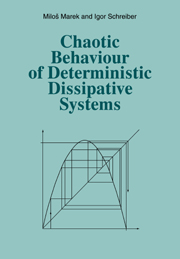Book contents
- Frontmatter
- Contents
- Preface
- 1 Introduction
- 2 Differential equations, maps and asymptotic behaviour
- 3 Transition from order to chaos
- 4 Numerical methods for studies of parametric dependences, bifurcations and chaos
- 5 Chaotic dynamics in experiments
- 6 Forced and coupled chemical oscillators – a case study of chaos
- 7 Chaos in distributed systems, perspectives
- Appendix A Normal forms and their bifurcation diagrams
- Appendix B CONT – a program for construction of solution and bifurcation dia-grams
- Index
6 - Forced and coupled chemical oscillators – a case study of chaos
Published online by Cambridge University Press: 24 November 2009
- Frontmatter
- Contents
- Preface
- 1 Introduction
- 2 Differential equations, maps and asymptotic behaviour
- 3 Transition from order to chaos
- 4 Numerical methods for studies of parametric dependences, bifurcations and chaos
- 5 Chaotic dynamics in experiments
- 6 Forced and coupled chemical oscillators – a case study of chaos
- 7 Chaos in distributed systems, perspectives
- Appendix A Normal forms and their bifurcation diagrams
- Appendix B CONT – a program for construction of solution and bifurcation dia-grams
- Index
Summary
In this chapter we discuss in detail two examples of dynamical systems. The first example shows the use of one-dimensional maps for the interpretation of chaotic and periodic regimes observed in experiments with a periodically forced chemical oscillator. The second example illustrates the use of numerical techniques for the investigation of chaotic phenomena in a model of coupled reaction diffusion cells.
Periodically forced continuous stirred tank reactor
There are several reasons for the interest in periodically forced chemical reactors. First, advances in electronics and computer technology make the controlled operation of chemical systems under periodically varying conditions feasible. Periodically operated processes might possess advantages over steady state processes as discussed by Bailey. Second, forced chemical systems serve as simple experimental analogues of various dynamical systems arising at different levels of organization of living systems, for example synthesis of proteins, cell cycles, tissue growth, excitatory tissues, physiological control systems, etc. Third, chemical systems, particularly oscillatory reactions, serve as prototype experimental systems for studies of transition to chaos in dissipative systems.
A particularly interesting and important case arises when undamped oscillations of the limit cycle type occur in the flow-through reaction cell.
This type of dynamical systems is called an oscillator. Another important case of chemical dynamical systems is an excitable system or excitator. Excitators are characterized by a non oscillatory behaviour in the absence of external forcing, but they can be excited and become oscillatory under superthreshold periodic perturbations.
- Type
- Chapter
- Information
- Chaotic Behaviour of Deterministic Dissipative Systems , pp. 203 - 271Publisher: Cambridge University PressPrint publication year: 1991



